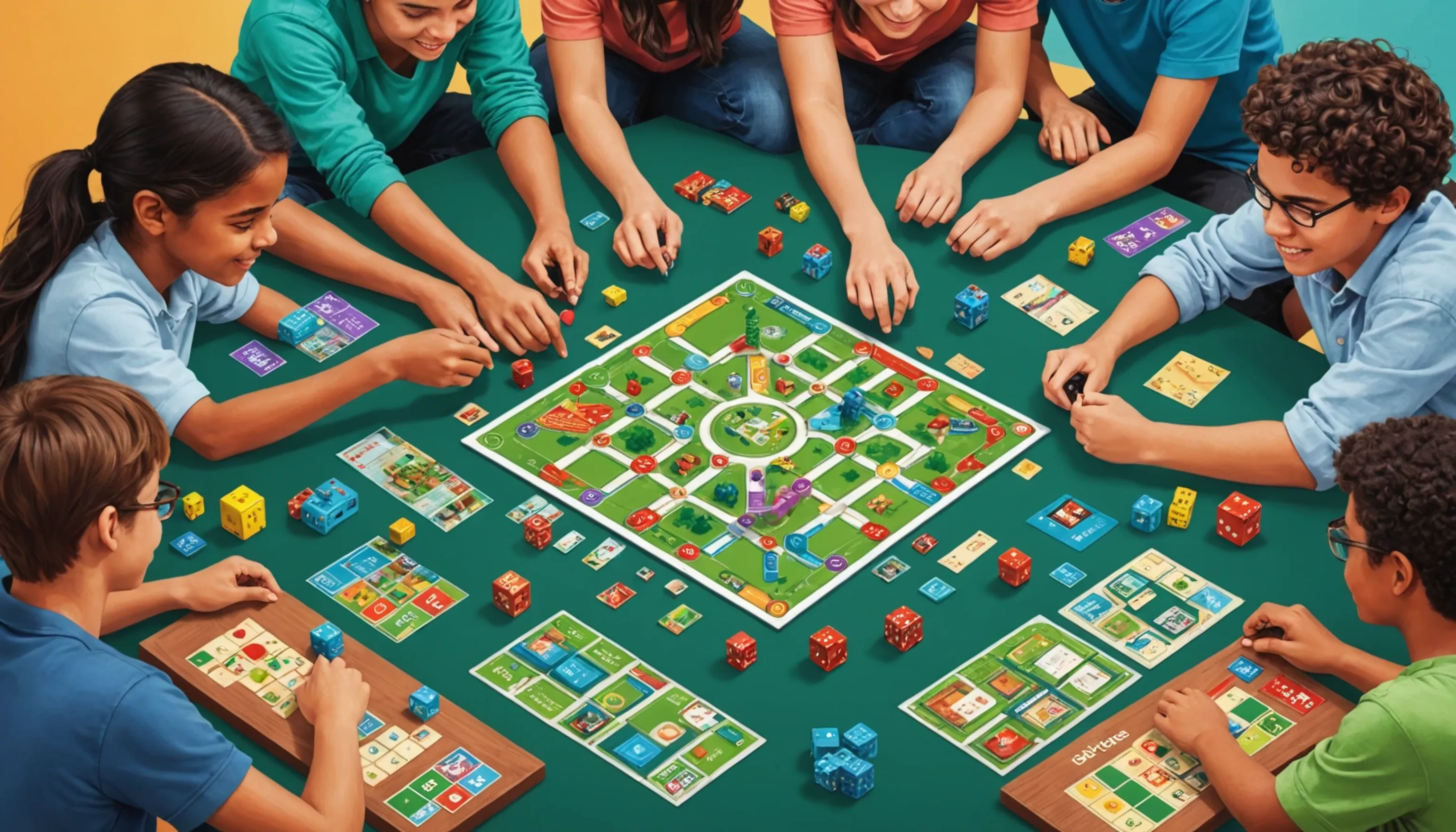STEM Games for Teens
 HvWHenry van Wagenberg
HvWHenry van Wagenberg
Understanding STEM Games: What Are They?
STEM games are interactive and educational activities designed to engage teenagers in the fields of Science, Technology, Engineering, and Mathematics. These games can take various forms, including video games, board games, and hands-on projects. They often emphasize problem-solving, critical thinking, and creativity.
By combining fun with education, STEM games aim to enhance students' understanding of complex concepts while fostering a passion for these subjects. As technology continues to evolve, so do the opportunities for teens to explore STEM through engaging and innovative gameplay.
Benefits of STEM Games for Teenagers
STEM games offer numerous benefits for teenagers, making learning both enjoyable & engaging. One of the primary advantages is that they enhance critical thinking skills. By solving puzzles & challenges within the games, teens learn to analyze situations, make decisions, & develop solutions, all of which are essential skills in both academic & real-world scenarios.
Another significant benefit is the promotion of collaboration & teamwork. Many STEM games require players to work together to achieve a common goal, fostering communication & social skills. This collaborative environment helps teens learn the value of teamwork, which is crucial in today’s interconnected world.
Moreover, STEM games often encourage creativity. Teenagers are prompted to think outside the box, experimenting with different approaches to solve problems. This freedom to create & innovate nurtures their imagination & inspires them to explore new ideas.
Additionally, these games can boost motivation & engagement. By integrating fun into learning, teens are more likely to invest time & effort into mastering STEM concepts. This increased engagement can lead to improved academic performance & a greater interest in pursuing careers in STEM fields.
Lastly, STEM games help to build resilience. As teens encounter challenges & setbacks in the game, they learn to persevere & adapt, instilling a sense of determination that will benefit them in all areas of life.

Types of STEM Games Available
There are various types of STEM games available, each designed to engage teenagers in unique ways while fostering essential skills. One popular category is board games, which often focus on strategy and teamwork. Games like Robot Turtles and Code Master teach programming basics and logical thinking through interactive play.
Another category is video games, which have become increasingly popular in recent years. Titles such as Kerbal Space Program and Minecraft: Education Edition allow players to explore scientific concepts, such as space exploration and architectural design, in a fun and immersive environment.
Hands-on activities also fall under the STEM games umbrella. Kits like LEGO Mindstorms and Snap Circuits enable teens to build their own robots and electronic devices, promoting engineering and coding skills through experimentation.
Online platforms and apps have emerged as another avenue for STEM gaming. Websites like Code.org and Scratch provide interactive coding challenges and projects, allowing teens to learn programming in a user-friendly way.
Lastly, escape room games have gained popularity, often incorporating STEM challenges that require teamwork, problem-solving, and critical thinking to “escape” within a set time. These games encourage collaboration and strategic planning, making them an exciting way to learn.
How to Choose the Right STEM Game
Choosing the right STEM game for teenagers involves several key factors. First, consider the interests of the teen. Whether they prefer coding, engineering, or scientific exploration, selecting a game that aligns with their passions will enhance engagement.
Next, assess the educational value. Look for games that promote critical thinking & problem-solving skills. Additionally, consider the game’s age appropriateness, ensuring it matches the teen’s maturity level.
Finally, read reviews & recommendations from other parents or educators. This can provide insights into the game’s effectiveness and enjoyment, helping you make an informed choice.

Criteria for Selecting STEM Games
When selecting STEM games for teenagers, it's crucial to use specific criteria to ensure that the chosen games provide both educational value and enjoyment. Here are some essential factors to consider:
- Educational Value: The game should promote learning in one or more STEM areas, such as science, technology, engineering, or mathematics. Look for games that challenge players to think critically and solve problems.
- Age Appropriateness: Ensure the game is suitable for the teenager's age group. The complexity of the game's content should align with their cognitive development & interests.
- Engagement: Choose games that are fun and engaging. If a game captures a teenager's attention, they are more likely to invest time and effort in learning.
- Collaboration: Opt for games that encourage teamwork and social interaction. Many STEM games are designed for multiple players, fostering collaboration and communication skills.
- Reviews and Recommendations: Look for feedback from other parents, educators, or online communities. Reviews can provide valuable insights into the game's effectiveness and overall experience.
- Adaptability: A good STEM game should allow for different levels of difficulty or offer various challenges, catering to diverse skill sets and keeping the learning experience fresh.
By considering these criteria, you can choose the right STEM games that effectively enhance learning and spark curiosity in teenagers.
Popular STEM Games for Teens
There are numerous popular STEM games that engage teenagers while promoting learning in science, technology, engineering, and mathematics. Here’s a list of some well-regarded games:
- Kerbal Space Program: This space flight simulation game allows players to design and launch their own rockets. It teaches concepts related to physics, aerodynamics, and space exploration while providing an exciting gaming experience.
- Minecraft: Education Edition: This version of the classic building game includes features specifically designed for educational purposes. It encourages creativity, problem-solving, and teamwork through collaborative projects.
- CodeCombat: A coding game that teaches programming through interactive challenges. Players learn languages like Python and JavaScript while navigating levels and solving problems, making coding accessible and enjoyable.
- LEGO Mindstorms: This hands-on robotics kit allows teenagers to build and program their own robots. It combines engineering principles with coding, sparking interest in robotics and technology.
- Robot Turtles: A board game that teaches the basics of programming through fun and engaging gameplay. Players use cards to move their turtles and overcome obstacles, introducing young minds to coding concepts.
- Escape Room in a Box: This game creates a thrilling escape room experience at home. It involves solving puzzles and riddles that require teamwork and critical thinking, making it an exciting way to apply STEM skills.
These games not only entertain but also equip teens with valuable skills, making them an excellent choice for both parents and educators.
Incorporating STEM Games into Learning
Incorporating STEM games into learning can significantly enhance teenagers' educational experiences. Start by integrating these games into the curriculum, allowing students to explore concepts through interactive play. For example, use coding games to reinforce programming lessons or robotics kits for engineering projects.
At home, parents can encourage gameplay that aligns with academic subjects. Setting aside time for STEM game nights can promote family bonding while fostering critical thinking skills. Additionally, educators can create challenges or competitions based on STEM games, motivating students to engage actively with the material and apply their knowledge in fun ways.
Using STEM Games at Home
Using STEM games at home can be an effective way to enhance learning while ensuring that teenagers have fun. Here are some strategies for incorporating these games into your home environment:
- Game Nights: Set aside a specific night each week dedicated to STEM games. This can be a family event where everyone participates. Choose games that promote teamwork and collaboration, such as Robot Turtles or Escape Room in a Box, to encourage communication and problem-solving skills.
- Integrate with Homework: Pair STEM games with school assignments. For instance, if a teen is learning about physics, suggest playing Kerbal Space Program to explore concepts of gravity and motion in a fun way.
- Encourage Creative Projects: Use hands-on kits like LEGO Mindstorms or Snap Circuits to inspire creative engineering projects. Set challenges where teenagers design their own robots or electronic devices, fostering innovation and critical thinking.
- Online Resources: Explore online platforms that offer interactive STEM games. Websites like Code.org provide coding challenges that can be completed at home, allowing teens to learn programming at their own pace.
- Discuss and Reflect: After playing, engage in discussions about what they learned. Ask open-ended questions to encourage deeper thinking and application of concepts.
By incorporating STEM games at home, parents can create a stimulating learning environment that promotes curiosity and a love for science and technology.
STEM Games in the Classroom
Integrating STEM games into the classroom can transform traditional learning into an engaging and interactive experience for teenagers. Here are several effective strategies for incorporating these games into educational settings:
- Curriculum Alignment: Choose STEM games that align with the curriculum. For example, using Minecraft: Education Edition can help students understand architectural design and physics concepts while allowing them to create structures in a virtual environment.
- Group Activities: Organize group challenges where students work together to solve problems or complete tasks using STEM games. This promotes teamwork and communication skills. Games like Escape Room in a Box can be used to create collaborative problem-solving scenarios.
- Hands-On Learning: Incorporate hands-on STEM kits, such as LEGO Mindstorms or Snap Circuits, into lessons. These activities encourage creativity and engineering skills as students build and program their own projects.
- Competitions: Host STEM game competitions or tournaments in the classroom. This not only encourages friendly rivalry but also motivates students to engage deeply with the material. Consider using coding games or robotics challenges to spark interest.
- Reflection and Discussion: After playing, facilitate discussions about the concepts learned. Encourage students to share their strategies and thought processes, reinforcing the lessons and promoting critical thinking.
By effectively integrating STEM games into the classroom, educators can create an enjoyable and enriching learning environment that fosters a passion for science, technology, engineering, and mathematics.
